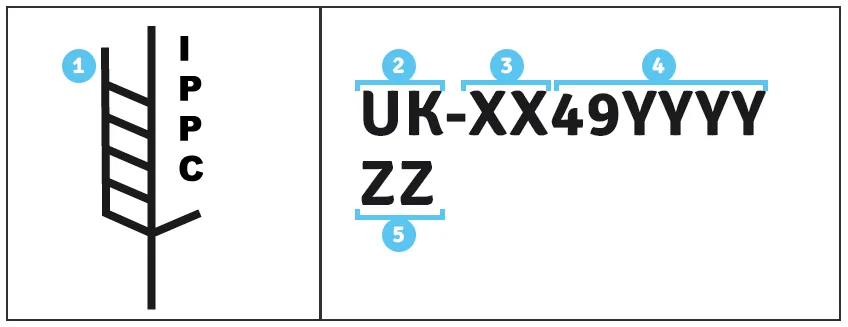
ISPM 15 is an international standard for phytosanitary measures designed specifically to regulate wood packaging material in international trade. The purpose of this standard is to prevent the spread of pests and diseases that can affect wood. This is achieved through specific treatments and markings that must be globally recognized and adhered to. A central component of the ISPM 15 standard is the ISPM 15 stamp, which provides important information about the origin and treatment of the wood packaging material.
The ISPM 15 stamp consists of several essential components, each containing specific information:
Left Part: Here, you will find the IPPC logo, symbolizing that the packaging complies with international phytosanitary standards.
Right Part: This area contains information about the country of origin, the manufacturer or treater of the packaging, and the type of treatment.

According to ISPM 15 and the EU Regulation 2016/2031 for the protection against plant pests, the marking must have a frame, and the logo must be separated from the rest of the marking by a vertical line. The frame can be interrupted.
The size and format of the marking are not strictly defined, but they must be clearly legible and permanently affixed to the wood. The frame and the separation line between the IPPC logo and other information must be clearly visible.
Only registered and authorized companies are allowed to mark and market packaging wood according to ISPM 15. These regulations are laid down in EU Regulation 2016/2031 on the protection against plant pests, particularly in Article 98.
The marking must be applied using a branding iron or stencil. Hand-painted markings are not permitted, nor are markings in the form of plaques, foils, or tags, as they do not meet the criteria of being “permanent” and “non-transferable.”

A wood packaging unit must be seen as a whole, with preference for marking the solid wood parts. If necessary, the marking can also be applied to wood-based materials, as long as the packaging is clearly identifiable as a unit.
Generally, additional documents such as plant health certificates or non-wood declarations for plywood or OSB panels are not required. For imports into the EU, no additional documents are needed. However, some countries outside the EU have specific requirements for fumigation, such as Australia, which requires a fumigation certificate.
The validity of packaging wood treated according to ISPM 15 is generally unlimited, as long as the marking remains clearly legible and intact. Re-treatment is only necessary if the packaging is repaired and more than one-third of the components are replaced.
When repairing, the used wood must also be ISPM 15 compliant, and the repaired parts must be individually marked. Alternatively, the old marking can be removed, and the entire packaging re-treated and re-marked. If more than one-third of the components are replaced, it is considered a new construction, and the entire packaging must be re-treated and marked.
Yes, the ISPM 15 standard allows the use of wood packaging with markings from other countries as long as the marking is legible and compliant.
Additional resources:
Source 1: ISPM 15 Standard
Source 2: ISPM 15 Treatment Methods
Source 3: ISPM 15 Country List





